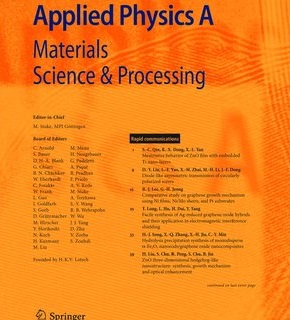The influence of microstructural evolution and phase structure on ferroelectric properties of La modified BaTiO3 ceramics synthesized via sol-gel and solid-state reaction methods
Abstract
This study examines the structural, ferroelectric, and energy storage properties of La-doped BaTiO3 ceramics synthesized using sol-gel (SG) and solid-state reaction (SSR) methods. Structural properties were verified by X-ray refinement and scanning electron microscopy (SEM). The SSR-derived ceramics feature a coarse-grained microstructure with larger grain sizes (5.57 μm), facilitating easier domain switching under an applied electric field of 62 kV/cm. This results in broader ferroelectric hysteresis loops and a maximum polarization (Pmax ≈ 17.87 µC/cm2). However, increased domain mobility leads to more significant energy loss during polarization reversal, resulting in an energy storage efficiency of 48%. In contrast, SG-synthesized ceramics exhibit a fine-grained microstructure (grain size ~ 5.57 μm) that restricts domain wall motion, yielding slimmer hysteresis loops with reduced energy losses and slightly lower polarization (Pmax ≈ 15.88 µC/cm2). Consequently, the SG samples demonstrate superior energy storage performance, achieving a higher energy efficiency of 64%. These results underscore the crucial impact of synthesis methods on microstructural features and functional properties, particularly for energy storage applications. This research provides valuable insights into designing and optimizing BaTiO3 ceramics for advanced energy storage and capacitor applications.
Graphical Abstract
A schematic diagram highlights the distinct microstructural, ferroelectric, and energy storage properties of BLaT5% synthesized through solid-state reaction (SSR) and sol-gel (SG) methods. The SSR sample exhibits a coarse-grained microstructure with larger grain sizes, which promotes easier domain switching under an applied electric field. This results in a broader ferroelectric hysteresis (P-E) loop, indicating higher energy loss during polarization reversal. In contrast, the SG sample demonstrates a fine-grained microstructure with significantly smaller grain sizes. This refined grain structure restricts domain wall motion, leading to a slimmer P-E loop with reduced hysteresis loss. Consequently, the SG sample achieves superior energy storage performance with higher energy efficiency and recoverable energy density. The comparison underscores the critical role of synthesis methods in tailoring microstructural features and optimizing functional properties for energy storage applications

 求助内容:
求助内容: 应助结果提醒方式:
应助结果提醒方式:


